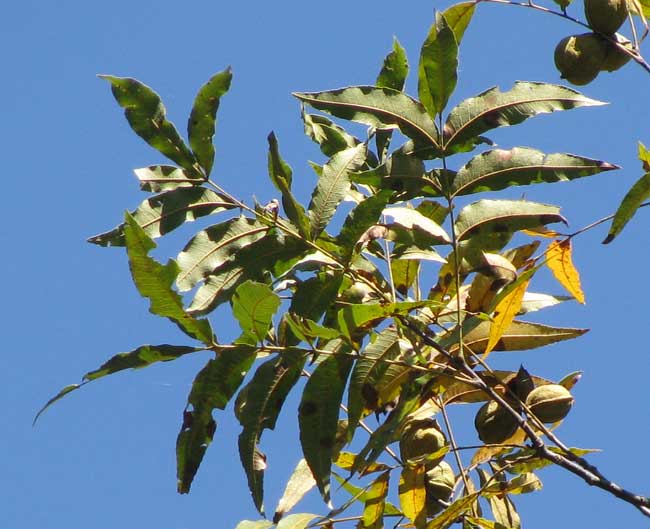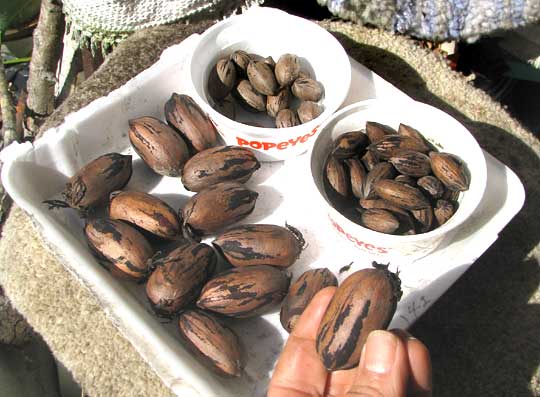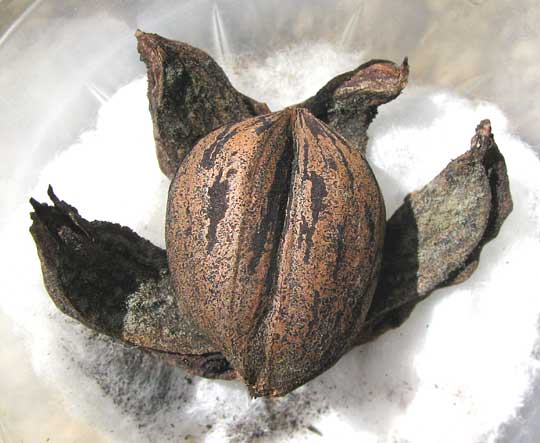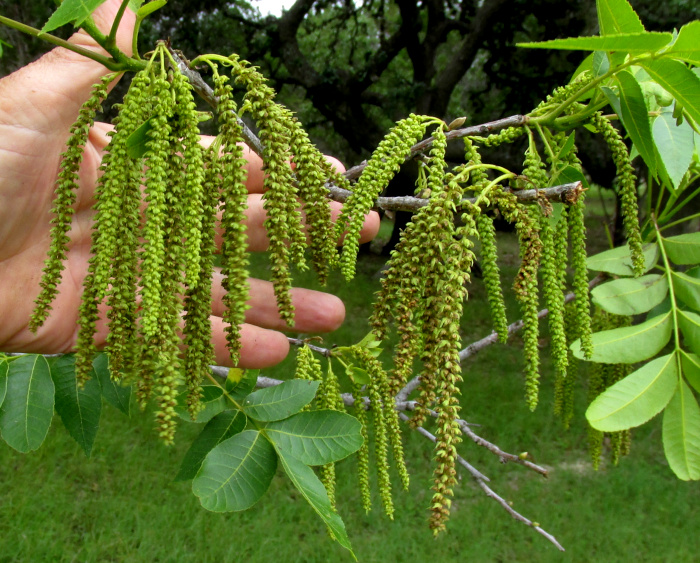Excerpts from Jim Conrad's
Naturalist Newsletter

from the the November 1, 2009 Newsletter, from near Natchez, Mississippi
PECANS FALLING
If you drive around Natchez these days you'll see many lawns populated by large Pecan trees, CARYA ILLINOENSIS, and here and there there'll even be entire Pecan orchard whose trees now are heavily laden with nuts. Sometimes you see big van-type trucks parked along the highway beside large, sloppy signs reading "We buy pecans!" Because of late-summer and fall rains there's a big crop of pecans this year, but from what I've seen a good half of them are wormy or fungusy inside. A wild Pecan in Anna's Bottom is shown above.
Below you see pecan nuts dangling from their opening- up husks, the nuts with their typical black mottling:

Pecans, being members of the genus Carya, are hickories. Pecan trees, like other hickories, bear alternate leaves (one leaf at a twig node), and each leaf is pinnately compound. So, in the above picture, you can see that each compound leaf consists of, usually, seven to thirteen leaflets? Pecan leaflet shape is unusual in that they curve like a sickle blade. Such blades are said to be "falcate."
Pecan trees are native to the south-central US as far north as Illinois, plus here and there in northern Mexico. You can see a map of their native range here.
Karen's mother maintains a Pecan orchard next to her house. She enjoys picking them up and supplying her friends with them, including me. You'd be surprised how much variation in nut size, form and taste there is from tree to tree. You can see some variety below:

Dozens of pecan cultivar names can be looked up at http://extension-horticulture.tamu.edu/carya/pecans/pecalph.htm.
You can see the prize finding of Karen's mom -- a "double pecan" -- in its exhibition container below:

Issued May 5, 2021 from the valley of the Dry Frio River, northern Uvalde County, southwestern Texas
PECANS FLOWERING
Nowadays the pecan trees bear many catkins of male flowers, as shown below:

Below, you see clusters of finger-like anthers filled with pollen hanging beneath a catkin scale.

Much less obvious female flowers are shown below.

from the November 4, 2001 Newsletter, from near Natchez, Mississippi
PICKING UP PECANS
This beautiful Sunday morning I have biked a few miles to a certain spot I know along Second Creek west of here, where Pecan trees grow next to a small country road. Here I can pick up pecan nuts without trespassing on private property. We have many Pecan trees at Laurel Hill, but I like these bottomland nuts better and I enjoy the ride through the countryside. Farmers have picked their cotton recently and now white fluff blown from wagons and trucks lies along the road looking like patches of snow.
Last year the crop was poor because of the drought and I didn't get to send some to my grandmother in Kentucky until after Thanksgiving. This year the crop is bounteous. In this morning's fresh air and dazzling sunlight it was a pure pleasure to rummage among the dry brown leaves finding all the shiny nuts I wanted.
Around my trailer the squirrels are keeping busy eating and burying pecans. Yesterday I heard a squirrel making a funny noise next to my cistern head. He was trying to bury a pecan in the very thin soil atop the cistern's flaring underground concrete shoulder. With a pecan in his mouth this squirrel just kept scratching at the concrete until I felt sorry for him. Finally it gave a violent flick of its tail, issued what was surely a squirrel-cuss, and rushed away.
This morning during breakfast an Eastern Chipmunk scampered from beneath my trailer, put on his brakes just a couple of feet from me and for a couple of surprised seconds looked at me goggle-eyed with his cheek-pouches hilariously bulging with what surely was pecans.
Pecan trees are native to this area and I can hardly imagine how they must have been appreciated by the Natchez Indians. For, pecans can be kept for many months. If a family has a cache of them, there never needs to be any worry about going hungry.
from the July 7, 2002 Newsletter, from near Natchez, Mississippi
PECANS UNDER ATTACK
Wednesday I checked to see how the pecans were developing and I was shocked. From nearly every cluster of nuts and from many terminal buds and new shoots dangled glistening, frothy masses of white foam. I confirmed that spittlebugs were responsible by blowing the foam away and finding aphid-size, white "nymphs" within. These nymphs, known as spittlebugs, were the immature stages of a kind of insect that in the adult stage is called a froghopper. As the nymphs sucked juice from the nut clusters they issued white foam all around them to dissuade birds and other critters from eating them.
The insect causing this infestation is the Pecan Spittlebug, CLASTOPTERA ACHATINA. On the Internet I learned that this species overwinters in the egg stage. The nymphs hatch in the spring, grow as they suck juices, and finally metamorphose into pale brown adults with a reddish tinge. The adults are called froghoppers because of their resemblance to frogs. The adult froghopper deposits its eggs in slits made in the bark of the previous season's growth.
One Web page said that if 5% of a tree's nut clusters were attacked, chemicals should be used. On our trees 95% or more of the clusters are infested, and many young shoots already are dead. Of course we won't use chemicals, for that would damage local ecology. Still, I dread to think what this infestation may mean to squirrels and other creatures for whom during part of the year pecans are the main diet.
Kathy Moody the plantation manager told me that the local folks say "If it rains in June, there won't be many pecans." Maybe our June rain encouraged the spittlebugs. I have watched the pecans mature through the summer each year I have been here but I've never seen them attacked by spittlebugs at all, much less in such incredible numbers.